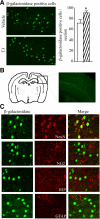Thyroid hormone regulates the expression of the sonic hedgehog signaling pathway in the embryonic and adult Mammalian brain
- PMID: 21363934
- PMCID: PMC3179409
- DOI: 10.1210/en.2010-1396
Thyroid hormone regulates the expression of the sonic hedgehog signaling pathway in the embryonic and adult Mammalian brain
Abstract
Thyroid hormone is important for development and plasticity in the immature and adult mammalian brain. Several thyroid hormone-responsive genes are regulated during specific developmental time windows, with relatively few influenced across the lifespan. We provide novel evidence that thyroid hormone regulates expression of the key developmental morphogen sonic hedgehog (Shh), and its coreceptors patched (Ptc) and smoothened (Smo), in the early embryonic and adult forebrain. Maternal hypo- and hyperthyroidism bidirectionally influenced Shh mRNA in embryonic forebrain signaling centers at stages before fetal thyroid hormone synthesis. Further, Smo and Ptc expression were significantly decreased in the forebrain of embryos derived from hypothyroid dams. Adult-onset thyroid hormone perturbations also regulated expression of the Shh pathway bidirectionally, with a significant induction of Shh, Ptc, and Smo after hyperthyroidism and a decline in Smo expression in the hypothyroid brain. Short-term T₃ administration resulted in a significant induction of cortical Shh mRNA expression and also enhanced reporter gene expression in Shh(+/LacZ) mice. Further, acute T₃ treatment of cortical neuronal cultures resulted in a rapid and significant increase in Shh mRNA, suggesting direct effects. Chromatin immunoprecipitation assays performed on adult neocortex indicated enhanced histone acetylation at the Shh promoter after acute T₃ administration, providing further support that Shh is a thyroid hormone-responsive gene. Our results indicate that maternal and adult-onset perturbations of euthyroid status cause robust and region-specific changes in the Shh pathway in the embryonic and adult forebrain, implicating Shh as a possible mechanistic link for specific neurodevelopmental effects of thyroid hormone.
Figures







Similar articles
-
Activation of the Sonic Hedgehog pathway in thyroid neoplasms and its potential role in tumor cell proliferation.Endocr Relat Cancer. 2012 Apr 10;19(2):167-79. doi: 10.1530/ERC-11-0305. Print 2012 Apr. Endocr Relat Cancer. 2012. PMID: 22241722
-
Subcellular localization of Patched and Smoothened, the receptors for Sonic hedgehog signaling, in the hippocampal neuron.J Comp Neurol. 2011 Dec 15;519(18):3684-99. doi: 10.1002/cne.22681. J Comp Neurol. 2011. PMID: 21618238 Free PMC article.
-
The hedgehog-patched signaling pathway and function in the mammalian ovary: a novel role for hedgehog proteins in stimulating proliferation and steroidogenesis of theca cells.Reproduction. 2009 Aug;138(2):329-39. doi: 10.1530/REP-08-0317. Epub 2009 May 11. Reproduction. 2009. PMID: 19433502
-
Small-molecule modulators of the Sonic Hedgehog signaling pathway.Mol Biosyst. 2010 Jan;6(1):44-54. doi: 10.1039/b910196a. Epub 2009 Aug 27. Mol Biosyst. 2010. PMID: 20024066 Review.
-
The role of Smo-Shh/Gli signaling activation in the prevention of neurological and ageing disorders.Biogerontology. 2023 Aug;24(4):493-531. doi: 10.1007/s10522-023-10034-1. Epub 2023 Apr 25. Biogerontology. 2023. PMID: 37097427 Review.
Cited by
-
A transient window of hypothyroidism alters neural progenitor cells and results in abnormal brain development.Sci Rep. 2019 Mar 15;9(1):4662. doi: 10.1038/s41598-019-40249-7. Sci Rep. 2019. PMID: 30874585 Free PMC article.
-
Thyroid hormone-induced sonic hedgehog signal up-regulates its own pathway in a paracrine manner in the Xenopus laevis intestine during metamorphosis.Dev Dyn. 2012 Feb;241(2):403-14. doi: 10.1002/dvdy.23723. Epub 2011 Dec 20. Dev Dyn. 2012. PMID: 22190352 Free PMC article.
-
Multisensory Stimulation Improves Cognition and Behavior in Adult Male Rats Born to LT4-treated Thyroidectomized Dams.Endocrinology. 2022 Sep 1;163(9):bqac105. doi: 10.1210/endocr/bqac105. Endocrinology. 2022. PMID: 35914267 Free PMC article.
-
Thyroid hormone and the neuroglia: both source and target.J Thyroid Res. 2011;2011:215718. doi: 10.4061/2011/215718. Epub 2011 Aug 23. J Thyroid Res. 2011. PMID: 21876836 Free PMC article.
-
Comparative proteomic analysis of regenerative mechanisms in mouse retina to identify markers for neuro-regeneration in glaucoma.Sci Rep. 2024 Oct 4;14(1):23118. doi: 10.1038/s41598-024-72378-z. Sci Rep. 2024. PMID: 39366989 Free PMC article.
References
-
- Porterfield SP, Hendrich CE. 1993. The role of thyroid hormones in prenatal and neonatal neurological development—current perspectives. Endocr Rev 14:94–106 - PubMed
-
- Anderson GW, Schoonover CM, Jones SA. 2003. Control of thyroid hormone action in the developing rat brain. Thyroid 13:1039–1056 - PubMed
-
- Anderson GW. 2001. Thyroid hormones and the brain. Front Neuroendocrinol 22:1–17 - PubMed
-
- Akaike M, Kato N, Ohno H, Kobayashi T. 1991. Hyperactivity and spatial maze learning impairment of adult rats with temporary neonatal hypothyroidism. Neurotoxicol Teratol 13:317–322 - PubMed
-
- Williams GR. 2008. Neurodevelopmental and neurophysiological actions of thyroid hormone. J Neuroendocrinol 20:784–794 - PubMed
Publication types
MeSH terms
Substances
Grants and funding
LinkOut - more resources
Full Text Sources
Miscellaneous

